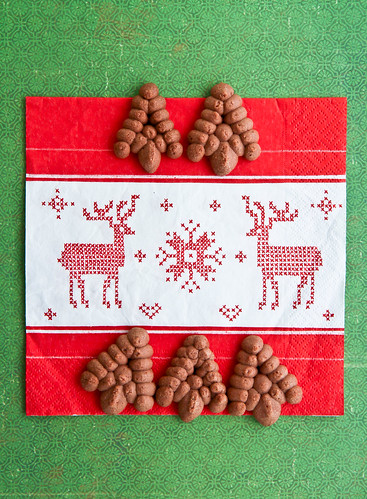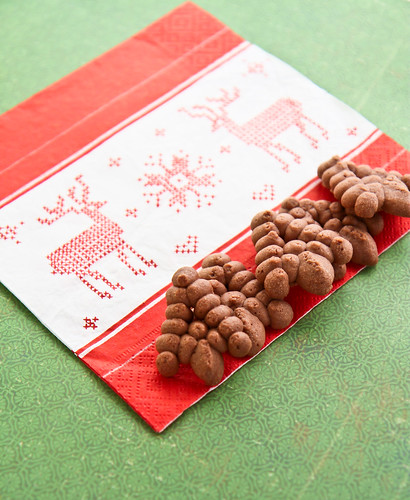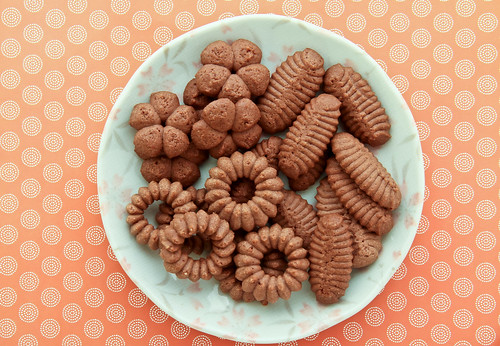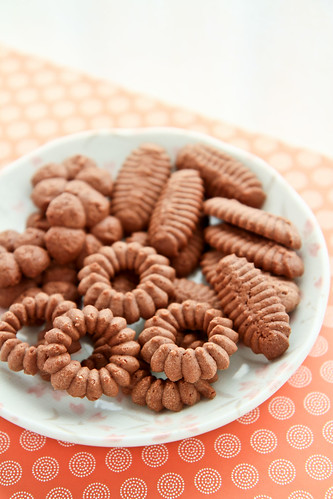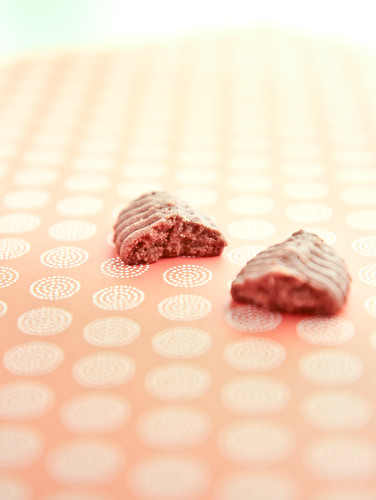I’ve to confess that I took a long time to overcome the hurdle that is sugar. I mean, I've seen the evils of sugar (see this super informative video "Sugar: the Bitter Truth") but after an epic no-sugar disaster (I tried to make no-sugar muffins using only the sweetness of fruits which failed more than majorly), I steered clear of anything labelled as no-sugar. Furthermore, I haven't had good experiences with sugar substitutes, as I find that most have a nasty or weird aftertaste to them. These two coupled together was a huge hurdle and I couldn’t get over the fact that anything without sugar would taste horrible and turn out blah.
But since my granny came over for a visit over Christmas and I wanted to bake some cookies for her, I had to make them sugar-free so that she could enjoy them without suffering the consequences later. So I began experimenting. I used the most simple of recipes – a butter cookie recipe. I made it sugar-free by substituting equal amounts of sugar substitute, xylitol for the sugar and I also changed it into a chocolate flavoured butter cookie.
But since my granny came over for a visit over Christmas and I wanted to bake some cookies for her, I had to make them sugar-free so that she could enjoy them without suffering the consequences later. So I began experimenting. I used the most simple of recipes – a butter cookie recipe. I made it sugar-free by substituting equal amounts of sugar substitute, xylitol for the sugar and I also changed it into a chocolate flavoured butter cookie.
 |
| My Christmas Cookie Selection (which are experiments for CNY actually) |
Now, my granny has not always been diabetic - in fact, she only tested positive only last year? I suspect old age has something to do with it. My uncle also has diabetes, of the more serious sort, and ever since then, I’ve been ever so conscious that all of us in the family are pretty susceptible too, and we should consciously note what kinds of sugars we are consuming. I’ve been reading up a lot on refined and natural sugars - in fact, as usual, I've come up with a huge long list of these sugars which I will share soon after I make it look more organized. So, I recently got myself some xylitol to experiment with. Why Xylitol? Well, after some reading up, I found that xylitol must suited to my needs. Most sugar alcohols when consumed in excess can cause some gastrointestinal side effects such as diarrhoea and bloating, and these are definitely symptoms I want to avoid. Xylitol on the other hand has a lower incidence of such side effects because it’s more easily tolerated than other types of sugar alcohols.
Xylitol is a naturally occurring sugar alcohol found in various sources such as corn husks, oats, mushrooms, etc. Mine however, is that which was extracted from birch. It has about 9 calories per teaspoon, about half of that of sugar. It also has a glycaemic index of 13. This is in comparison to refined white sugar which has a GI of about 65! The best thing of course, is that there is no nasty aftertaste like what you’ll get from some brands of stevia or other sugar substitutes. For those who might think - wow xylitol? Sounds totally exotic and foreign! I'm sorry to burst your bubble but xylitol is not something new. If you check your chewing gum or toothpaste, you might realize xylitol being used as one of the ingredients. It provides the necessary sweetness and it appears that it is also tooth friendly and helps reduce plaque and tooth decay as well! I haven’t been able to find xylitol in grain form in Singapore, so I got this shipped from UK along with other products (like xanthan gum).
Of course, there are other types of sugars suitable for diabetics, such as “Sugar-free” and Equal, the more common brands in the market. However, these are more of synthetic sugars and I don’t really want to put in any more artificiality into my body, so xylitol it is.
So onto the cookies. I used a cookie press to make them, and boy did I have tons of fun with it! I forgot my mom had such a contraption, and was only reminded when she saw me piping the cookies with a piping bag and commented that she had a cookie press in the drawers somewhere. I used the Christmas tree plate to create Christmas tree cookies for Christmas, which has of course since passed, but as you can see above, you can also create a whole melange of cookie shapes with the cookie press. It was my first time using the press, so if you scrutinize the plate above, you'll see varying shapes and sizes :/ There are so many plates to play around with, and you can get different shapes with the same plate if you just vary the amount of pressure used, so do play around with your cookie press if you have one, because these can be the perfect simple cookies to make for Chinese New Year. In fact, I believe I took less than 30 minutes to make the cookie dough, and press them out before baking. You can churn out jars of CNY cookies in less than a few hours :]
Of course, there are other types of sugars suitable for diabetics, such as “Sugar-free” and Equal, the more common brands in the market. However, these are more of synthetic sugars and I don’t really want to put in any more artificiality into my body, so xylitol it is.
Sugar-free (Xylitol) Chocolate Spritz Cookies
Makes about 50 odd cookies, depending on how large or small
Adapted from Pierre Herme's sable viennois
95g unsalted butter
¼ tsp fleur de sel
¼ tsp vanilla paste
40g xylitol (or any sugar substitute, or icing sugar for the non-sugar-free aka original version)
15g egg white
125g all-purpose flour
95g unsalted butter
¼ tsp fleur de sel
¼ tsp vanilla paste
40g xylitol (or any sugar substitute, or icing sugar for the non-sugar-free aka original version)
15g egg white
125g all-purpose flour
Method:
- Cream butter and salt until light and fluffy. Next, add in vanilla and sugar, making sure to beat well.
- Add in the egg white and beat until well incorporated.
- Sift in flour and mix until all the flour is incorporated. Do not over mix.
- Place the batter (it will be quite soft) into a piping bag with your selected tip and proceed to pipe out shapes. If the batter is too soft to handle, place it in the fridge to chill for less than 30 minutes. Do not place it in the fridge for too long as the batter will harden and it will be impossible to pipe out.
- Bake the cookies in a 160°C preheated oven for about 15 minutes. The cookies do not spread much, so you can pipe them quite close to one another, leaving less than 5cm spaces between each cookie.
Janine's jots:
- Taste: I couldn't taste an obvious difference between the sugar-free and refined sugar versions of the cookie actually, which means that this experiment is a success :] I mean, if you want to be particular, I thought the refined sugar version was probably more crunchy, but this version was definitely fine too!
- Texture: In my first batch, I accidentally added an entire egg white instead of the 15g required by the recipe, so the cookies didn't turn out as crispy as they should have, but the subsequent batch turned out fine. Using xylitol did make the texture of the cookies less crispy, but it was okay for me since this was meant for my grandma and I think she'd prefer a cookie with more 'bite'.
- Serving size: You can fill about one tin (those typical plastic jars with the red lids) of cookie using one batch of this recipe, so you might want to double or triple it if you wish to make a couple jars.
- Modifications: None, because I really like this recipe, although I do much prefer the original non-chocolate ones better. I think chocolate cookies need to be a tad sweeter.
- Storage: These cookies store very well at room temperature. Just be sure to keep them in an airtight container, and they will last for at least 2-3 weeks. If you store them in those disposable type plastic containers, they will start to lose their crispiness after a few days.
- Would I make this again?: Definitely, but my granny wants them to be normal butter cookies this time for CNY because she's superstitious and doesn't like 'orh' (black) things for CNY =X

